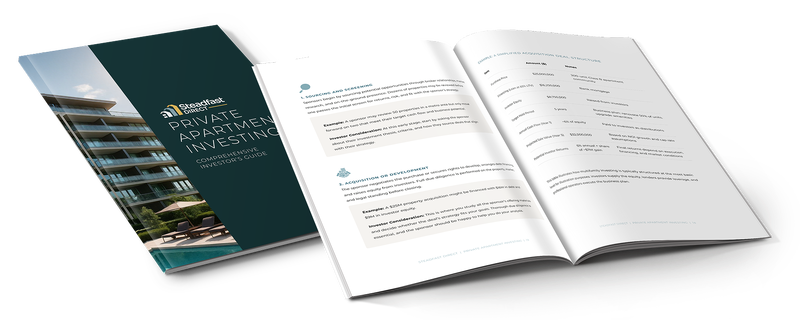Private real estate can feel opaque, even for seasoned investors. The Comprehensive Investor’s Guide to Private Apartment Investing is designed to make these concepts clear and straightforward. It plainly organizes the full lifecycle of a multifamily deal, from acquisition through exit, and explains the key metrics, risks, and structures you’ll need to be aware of.
What sets this guide apart is its practicality.
At each stage, it highlights the key points and the questions to ask, so investors can focus on and learn about what actually drives outcomes instead of getting lost in jargon.
What You’ll Find Inside
- Ways You Can Invest in Apartments
Public REITs, non-traded REITs, private funds, and direct private placements, compared by liquidity, control, diversification, typical minimums, and tax treatment. Includes a comparison table, Key Takeaways, and Questions to Consider so you can narrow the approach that fits your goals.
- Lifecycle of an Apartment Deal: Step by Step
From sourcing and screening → acquisition or development → operations → value-creation → asset management → distributions → potential refinance → exit. Each step pairs an example with Investor Considerations you can use while reviewing offerings.
- Key Metrics You’ll See in Multifamily Investing
Cap rate, IRR, cash-on-cash, equity multiple, DSCR (with LTV), occupancy/vacancy—defined with formulas, quick examples, and how to interpret them together. Includes Key Takeaways and Questions to Consider to keep the focus on assumptions that move results.
- Risks to Keep in Mind
Market/economic risk, financing & leverage risk, property-level/operational risk, and sponsor/execution risk—how each shows up, how experienced operators typically manage it, and simple investor checklists to spot red flags.
- Tax Benefits and Considerations
Depreciation, cost segregation/bonus depreciation, 1031 exchanges, and capital-gains treatment—plus important caveats (passive-loss rules, recapture, state taxes). Educational overview only; always confirm tax considerations with your CPA.
- Planning Your Hold Period and Exit
Typical 3–7 year holds (longer for development), common exit paths (sale, refinance, recapitalization), and why planning for illiquidity up front leads to better decisions. Includes Key Takeaways and Questions to Consider to align timing with your broader plan.
Why This Guide Matters
If your portfolio leans on stocks, bonds, or public REITs, direct apartment investing can add diversification and durable income potential, provided you understand how deals are structured and where returns and risks actually live or come from. The guide is a reference you can keep nearby to evaluate offerings with sharper eyes and decide if, and how, direct multifamily investing fits your goals. Also, this guide helps you ask sharper questions and stay informed as you explore direct apartment investing.

